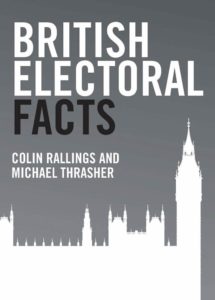British Electoral Facts – an essential reference work
For decades, FWS Craig was the doyen of British electoral statistics. His reference works were widely used and often contained facts and figures that he had created from original sources. Yet today he is almost completely unknown.
The reason? He died just before the internet took off. His hard work was locked away in reference volumes either sat on the shelves in libraries beyond the reach of an internet connection or available to purchase – at eye-wateringly expensive prices.
 Rather like the first person to map a geographic area, even as his name has been forgotten we are all still heavily dependent on the statistical landscape he first plotted. It’s a landscape he plotted with great care and attention, as I know personally, having spent a good part of my PhD years recreating statistics from original nineteenth century sources and comparing them with his calculations.
Rather like the first person to map a geographic area, even as his name has been forgotten we are all still heavily dependent on the statistical landscape he first plotted. It’s a landscape he plotted with great care and attention, as I know personally, having spent a good part of my PhD years recreating statistics from original nineteenth century sources and comparing them with his calculations.
One of his most used publications was British Electoral Facts, which went through five editions. It was revived in 2000 by Colin Rallings and Michael Thrasher, who have now published the sixth and seventh edition of this title.
The seventh edition has just been republished in a welcome paperback format at a reasonable price (under £20).
Although this publication is only just out, complete with a new cover, the contents are still that of the seventh edition published in September 2006. Therefore, in terms of general election statistics the book is up to date, but bear in mind that for other figures – such as the run of local election turnout numbers – the book only fleetingly covers our current Parliamentary cycle.
Even so, by pulling together a consistent set of numbers over time, the book lets the reader very easily put in context the latest figures that are thrown up by an election even if sometimes the last few years are missing. In a few cases the gap is even bigger as the data has come from sources which were published further in the past.
The book has all the broad basic numbers you might expect, such as general election results since 1832 and numerous related numbers. One small quibble: by giving figures even from years such as 1832 to one decimal place, the book implies that the numbers are accurate than in fact is warranted given the quality of the original data. It’s rather like publishing current opinion poll data to two decimal points. You can do it, but the errors involved in the polling process make the second decimal point (and indeed usually the first) meaningless. Gratuitous decimal pointing is sadly one of the statistical curses of our age.
Inevitably there is a slight random feel to some of the statistics which are included because they happen to have been compiled – because someone happened to want them at some point in the past and therefore asked a Parliamentary question or similar.
How many people are likely to want to know the number of voluntary patients in mental hospitals in Northern Ireland in 1996 – and turn to a book on electoral facts for the answer? (Page 102 by the way.)
But then that is part of the charm of such a book, with the pleasantly curious surprising statistic always just a few turns of the page away. An example is the table showing the number of polling stations and how they’ve been falling steadily at elections , just the sort of figures that provides useful background to the talk earlier this year about cutting the number of polling stations further.
I doubt I’ll come across a need to know the number of ballot papers in Scotland in 1959 spoilt for having writing or a mark by which the voter could be identified, but there are numerous other statistics which will come in useful.
The book has a smattering of small errors, such as in historic Gallup figures from the 1950s, but overall it is solid content across an interesting range and to good production standards, which is particularly welcome in a reference book likely to get repeated use.
Leave a Reply